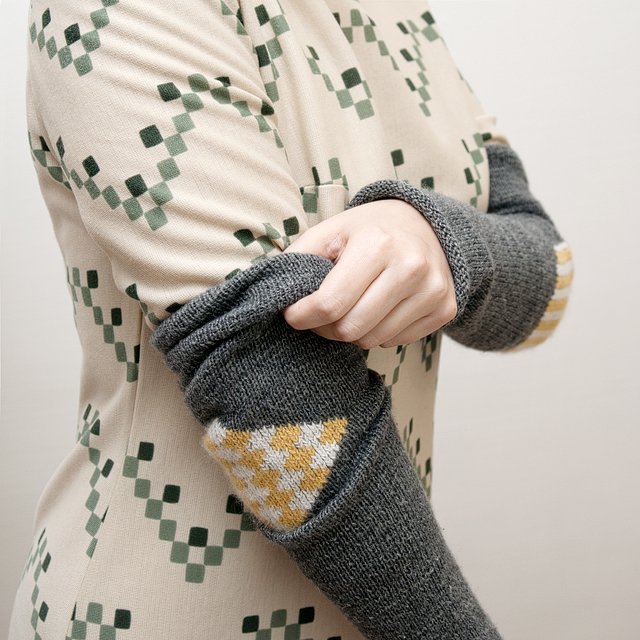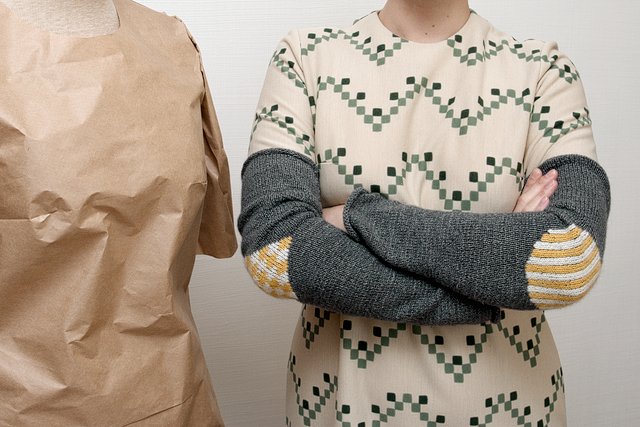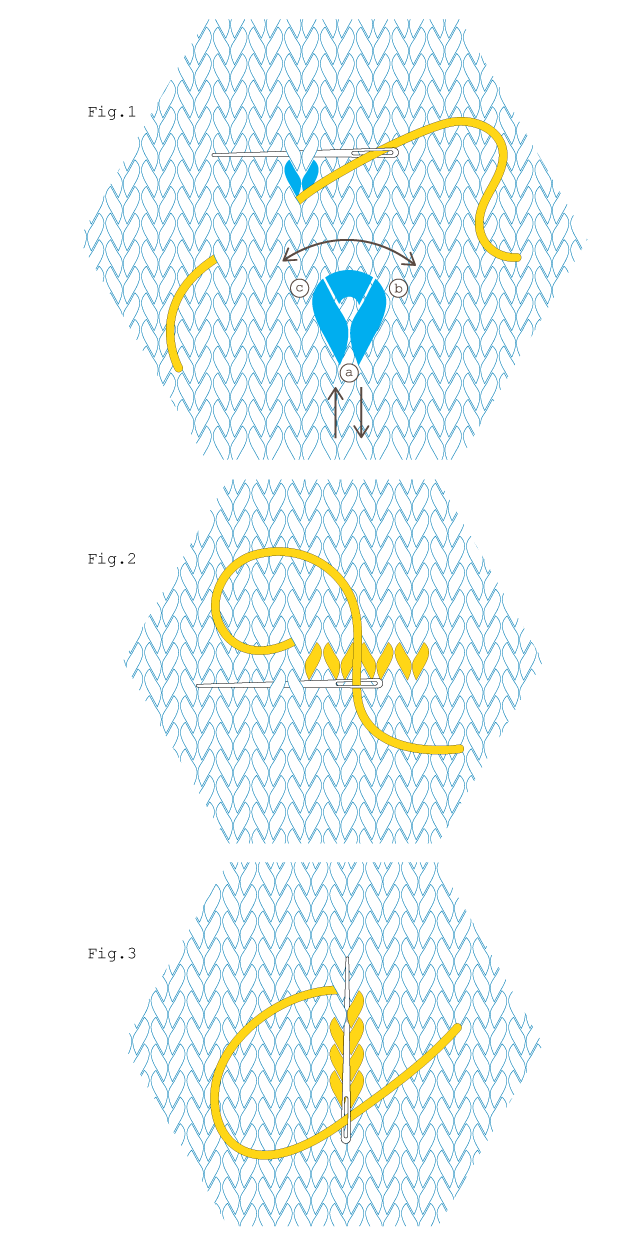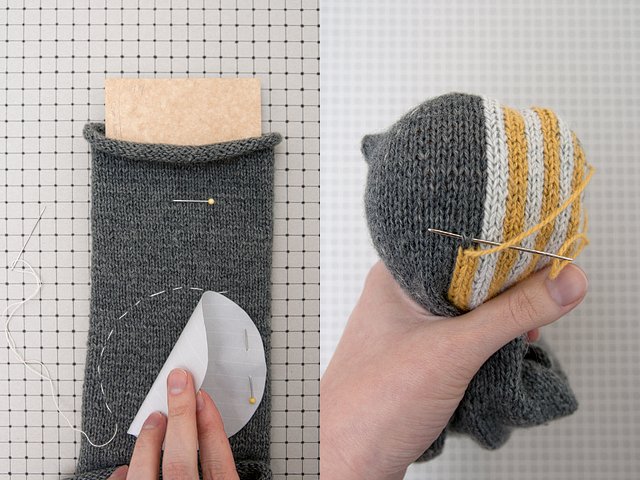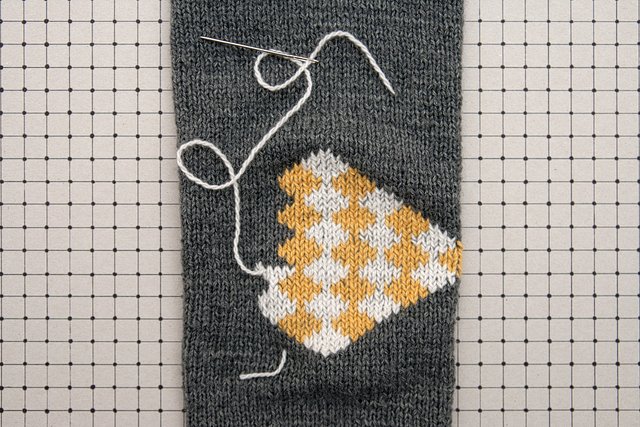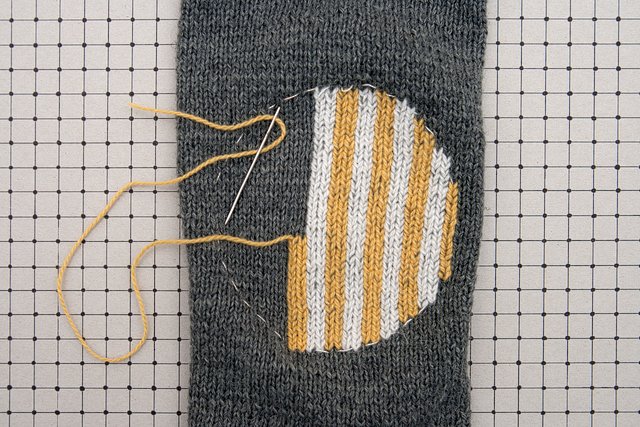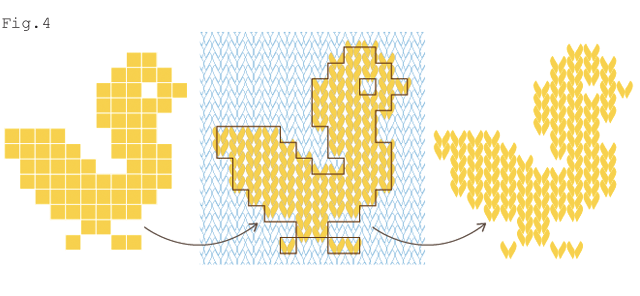Creative Mending – Part 1: Swiss darning
This first part of the tutorial is about strengthening thinned areas in your knits using Swiss darning or duplicate stitch. Ideally you should do this before you get a hole in them! You can use it for reinforcing elbows, heels or toes or just as an embellishment to your knits. I chose these sleeves or arm warmers which I've been wearing for a couple of years now; the elbow area had started to get too soft and shiny. Just in time for mending action!
How-to:
This technique is to be used on stockinette stitch which, unlike other more textured stitches, gets worn easily. First, start by seeing the stitches in your knit as "V"s (not inverted "V"s".) You will be redoing each stitch with needle and yarn following this sequence: the needle goes up in (a), to go then from (b) to (c) – or the other way round depending if you are going left or right in that row (Fig. 1). Insert the needle back in (a) and bring it up in the (a) point of the stitch immediately to the side (Fig. 2) or above (Fig. 3) the one you've just stitched. Don't pull too tight the stitches.
Now, for stitching your design in the area to be mended, you can follow a chart and go counting each stitch (as I've done with the diamond motif) or you can outline the zone and then fill in freely. For doing this, cut out the shape you want in paper, place a piece of cardboard behind the area you will be stitching, pin the paper pattern on the knit and using a running stitch with a contrast colour, outline the shape of the cut out. Remove the cardboard and insert your darning egg or ball or gourd and start stitching!
You can translate your own motif to stockinette stitch by outlining your design on this template and colouring the areas that fall inside the lines (Fig.4) Alternatively you can use a web app such KnitPro 2.0 to convert your images to a knit chart.
Check the other posts in this series:
• Creative mending – What you need
• Creative mending – Part 2: Patches
[Español]
Esta primera parte del tutorial es para aprender a reforzar las áreas debilitadas en los tejidos usando el punto de malla. Lo ideal es adelantarse y hacerlo antes que aparezca un hoyo! Lo puedes aplicar en los codos, talones o dedos del pie, o simplemente como decoración. Escogí estas mangas o calentadores de brazos que he estado ocupando por unos años y los codos ya se estaban poniendo muy suaves y brillantes. ¡Justo a tiempo para actuar!
Cómo se hace:
Esta técnica es para ser utilizada sobre punto jersey el que, a diferencia de otros puntos de tejido más texturados, tiende a desgastarse fácilmente. Lo primero aprender es mirar las puntos del tejido como "V"s en vez de "V"s invertidas. Se trata de ir rehaciendo cada punto con aguja y lana siguiendo este orden: la aguja sale en (a) y luego pasa de (b) a (c) – o en el sentido contrario dependiendo si se va hacia la izquierda o la derecha en esa corrida (Fig. 1). Insertar la aguja de vuelta en (a) y sacarla en el punto (a) del punto inmediatamente al lado (Fig. 2) o arriba (Fig. 3) del que se acaba de hacer. No apretes las puntadas.
Ahora, para aplicar el diseño en el área que queremos cubrir, se puede seguir un gráfico e ir contando cada uno de los puntos o se puede delinear la zona para luego rellenarla libremente. Para hacer esto, corta en papel la figura que quieras darle al parche, inserta un pedazo de cartón bajo el área que se coserá, fija con alfileres el papel y utilizando un hilván en color contrastante, delinea todo el contorno del molde de papel. Retira el cartón e introduce ahora el huevo o pelota o calabacita para zurcir y a comenzar a coser!
Puedes convertir tu propio diseño para punto jersey dibujando el contorno de tu motivo sobre esta plantilla y luego coloreando las partes que quedan dentro de las líneas (Fig.4). También puedes utilizar una aplicación online como KnitPro 2.0 para transformar tus imágenes en gráficos para tejido.
Revisa los otros posteos de esta serie:
• Creative mending – What you need (los materiales que necesitarás)
• Creative mending – Part 2: Patches (Parte 2: Parches tejidos)

